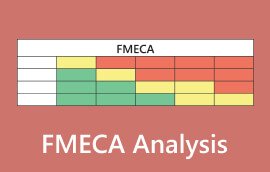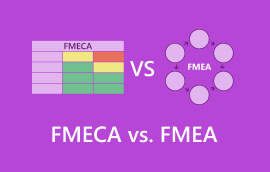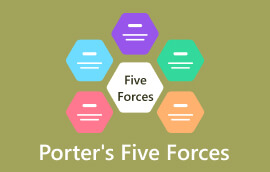A Comprehensive Comparison of Agile vs. Waterfall Methodologies
In the world of project management, two popular methods stand out: agile and waterfall. These two approaches have different ways of tackling projects. Thus, understanding their differences can help you choose the right one for your team. If you’re having a hard time choosing the right one, you are in the right place. Here, we’ll take a closer look at agile and waterfall project management. As you read, you’ll know their similarities, differences, and definitions. Finally, we will introduce the best tool you can use for creating a diagram for these.

- Part 1. What is Agile
- Part 2. What is Waterfall
- Part 3. Differences Between Agile vs. Waterfall
- Part 4. Similarities of Agile vs. Waterfall
- Part 5. Bonus: Best Diagram Maker for Agile and Waterfall
- Part 6. FAQs About Agile vs. Waterfall
Part 1. What is Agile
Before knowing the differences between agile and waterfall, understand their definition first. So, keep reading to learn more.
Agile is an iterative and flexible form of project management. It emphasizes adaptability that embraces changes of direction even late in the procedure. Agile is about collaboration, making customers satisfied, and continuous refinement. Apart from that, it breaks down big projects into small components. With the changing needs of customers, agile flexibility is becoming essential. Thus, it is all about getting better results.

Main Uses
◆ It is usually used in software development projects.
◆ Teams can apply it to various project types. And so, it allows adaptability and continuous improvement.
◆ Teams or organizations can use it to create or enhance products. It supports iterative development based on customer needs.
PROS
- Agile allows changes and adjustments throughout the project.
- It focuses more on customer feedback to ensure the product meets user needs.
- Agile encourages close collaboration among team members. So it enhances communication and teamwork.
- It has better visibility or accountability.
CONS
- Its flexibility can sometimes lead to uncertainty.
- It often prioritizes working software over extensive documentation.
- It is not ideal for projects with well-defined and unchanging requirements.
Part 2. What is Waterfall
The waterfall is a traditional and linear project management approach. It is where you need to complete the task in a step-by-step sequence. Its rigid structure and predetermined phases usually characterize it. Oftentimes, it is effective for straightforward projects that need minimal adaptation. Hence, it may not be suitable for more complex initiatives.

Main Uses
◆ It is good for projects with clear and stable plans. It works well when you know what exactly needs to be done.
◆ It is a step-by-step process. With it, you do step one at a time, and you can’t proceed without finishing the previous step.
◆ One of the uses of the waterfall is for smaller and straightforward projects. Here, you don’t expect tons of changes along the way.
PROS
- It provides a solid plan for the project from start to finish.
- It uses a clear and structured approach.
- Easy to track progress and spot potential risks.
- It has a comprehensive documentation of its results and processes.
- Suitable for projects that are unlikely to change throughout the project.
CONS
- It is not helpful for projects with evolving requirements.
- It is not an ideal model for complex and large-size projects.
- Projects may take longer to complete. Each phase must finish before the next begins.
Part 3. Differences Between Agile vs. Waterfall
Here are 6 vital agile vs. waterfall project management differences you should know:
| Aspect | Agile | Waterfall |
| Approach | Agile is a flexible and adaptable approach. It allows changes throughout the project | Waterfall is a sequential and rigid approach. It has predefined stages and a linear progression. |
| Delivery | Agile gets things done fast with shorter project cycles. It gives you something that works after each small step. | In Waterfall, you have to finish everything before anything is ready to use. |
| Documentation | Agile emphasizes teamwork and self-organizing teams rather than extensive documentation. Yet some documentation is maintained. | On the other hand, a waterfall requires extensive documentation. Each stage and project progress must be defined. |
| Roles Delegation | In agile, team members should collaborate on different parts of the project. Thus, it leads to a more self-organizing structure. | In contrast, waterfall assigns roles to its project team members. Each member has specific responsibilities and duties. |
| Quality Control | Agile prioritizes testing and quality control. It allows for early detection and resolution of problems. | Waterfall, in contrast, performs quality control in the testing phase. As a result, it leads to late issue discovery. |
| Planning Process | In agile, planning is not done in advance. All the planning processes of agile teams are ongoing since they work on an active sprint. | In a waterfall, detailed planning is essential since teams do it once. It allows the team to achieve the goals they set for their project. Plus, they do not make any modifications to the scope and requirements of the project. |
Part 4. Similarities of Agile vs. Waterfall
Despite the differences between agile vs. waterfall, they also share some similarities. Below are some of the similarities of these two methodologies:
1. Project Goals
Both Waterfall and Agile aim to complete the projects successfully. They also want to deliver valuable results to the stakeholders.
2. Quality Focus
Both methods emphasize the importance of high-quality work. But note that approach the quality assurance in different ways.
3. Testing
Agile and waterfall both use different forms of testing tools and techniques. These tests include integration testing, system testing, unit testing, and many more.
4. Activities
These two methods perform the same activities. It includes the collection of requirements, designing, developing, and deploying.
5. Documentation
Agile and waterfall both use documentation. However, the amount and purpose of documentation differ.
6. Stakeholder Involvement
Both methodologies recognize the importance of involving stakeholders. These stakeholders are the clients and end-users throughout the project. Engaging stakeholders ensures their needs are addressed. At the same time, it helps them in creating a product that meets their expectations.
Part 5. Bonus: Best Diagram Maker for Agile and Waterfall
Do you need a diagram maker for your agile and waterfall project management? Worry no more. MindOnMap is here to help you. MindOnMap is a free web-based diagram maker that you can use to draw your ideas. It is accessible on various modern browsers, like Google Chrome, Safari, Edge, and more. If you want to use it offline, you may download its app version. What’s more interesting, it supports both Windows and Mac platforms. With it, you can create tons of diagrams. In fact, it offers several diagram templates that you can use. It includes treemaps, organizational charts, flowcharts, and fishbone diagrams. To better personalize your diagram, it provides different icons, shapes, and themes. Plus, you can insert links and pictures as you wish.
Apart from that, it offers an auto-saving feature. So, when you stop working in a few seconds, the tool will save it for you. Thus, it prevents you from losing any valuable data. MindOnMap also lets you share your work with your teams, friends, and so on. Hence, they can view and get new ideas with your work. MindOnMap has a lot more to offer. Also, creating a diagram for your agile and waterfall is easier with it. So, try the tool now to know its full capabilities!
Secure Download
Secure Download

Part 6. FAQs About Agile vs. Waterfall
What are the key differences between agile vs waterfall vs scrum?
As discussed above, agile is a flexible and iterative approach. In contrast, waterfall is a linear, step-by-step approach. Now, scrum is a specific framework within Agile. It focuses on small, time-boxed iterations called sprints.
Why Agile is preferred over Waterfall?
Agile is preferred by many for various reasons. One is because several projects deal with changing requirements. Another thing is that there’s also a need for continuous customer feedback. Finally, Agile allows for flexibility and adaptation during the project. Thus, it is more suitable for many industries.
What are the disadvantages of Agile?
Although agile is preferred by many, it also has some drawbacks. First, there is a potential for increased project complexity due to its flexibility. Next, it always requires active customer involvement. Last but not least, it could lead to the possibility of uncertain project timelines.
Conclusion
In the end, you’ve learned more about the agile vs. waterfall. Whatever you choose, see to it that it will meet your project’s requirements and goals. You’ve seen that agile is outstanding for flexibility and delivering quick results. While the waterfall is excellent for structured and well-defined projects. Remember, there's no one-size-fits-all answer. In fact, you can even blend elements of both methods. Also, if you need a tool to create a diagram for your agile and waterfall methodology, use MindOnMap. It is a dependable tool for generating various charts for all your needs. Plus, it offers a straightforward way to craft your desired and personalized diagram.










